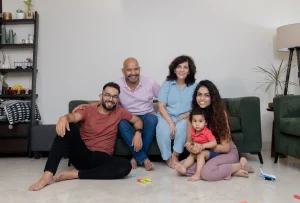When we think of divorce cases, we tend to see them as black and white. On the one hand, you can go to court, litigate, and engage in a long, bitter divorce fight. On the other hand, you can just agree on everything and have a simple, uncontested divorce.
What About Collaborative Divorce?

But the reality is that there is actually a third category for resolving divorce cases: collaborative divorce.
Think of collaborative divorce as a hybrid between extended bitter in-court fighting and simply agreeing on everything from the outset.
On the one hand, there may be real disagreements between the parties, and they may not even necessarily get along. But they may also want to avoid the drawbacks of long, draining, and expensive in-court litigation. That’s where collaborative divorce comes in.
Much like alternative dispute resolution, such as mediation, collaborative divorce happens outside of a court. In fact, collaborative divorce requires that no divorce cases have actually been filed. If a divorce case is pending and the parties want to try a collaborative divorce, they must agree to stay or pause the case during the collaborative process.
Collaboration also requires that the parties agree that they will not file any divorce case while the issues in the case are trying to be resolved collaboratively.
Getting Representation for Collaborative Divorce
Both parties can be represented by an attorney, just as they would in court. The attorney you select cannot just be a family law attorney but must be specifically trained in collaborative divorce. Be aware that if an attorney represents you for the collaborative divorce, and the issues are not resolved, that attorney cannot then later represent you in any future divorce case that may be filed. You would have to find and retain a new attorney.
Your attorney is your attorney and is acting on your behalf during the collaborative process. But unlike contested divorce litigation, the goal for the attorneys on both sides isn’t to “win the case,” but rather to work together to find an amicable and agreeable solution that works for all sides. At meetings, each side’s attorney may even speak to the other spouse to get an idea of what he or she wants in the divorce and why.
Just as in mediation, the attorneys for both sides will try to agree on a neutral—a middle person who will help both parties work through the issues and negotiate.
Trying to Get to an Agreement
Both parties must sign an agreement indicating their agreement to participate. The agreement also obligates both parties to honesty, full disclosure of information, and keeping the matters in the collaboration confidential. Confidentiality can be a major benefit—the details of your divorce, while normally public as a publicly filed case in court, are now largely shielded from the public eye.
The parties will then meet to work out the issues. Often, this takes many meetings, but the good thing is that unlike court hearings, which often happen when the judge or your attorney can schedule them, collaborative divorce sessions can often be scheduled around your work or life schedule, adding to the convenience of collaborative divorces.
Other professionals may need to get involved if necessary. For example, if there are tax, immigration, or estate planning issues, complex financial assets, or even mental health professionals who may be needed, these outside experts can be hired to help.
If successful, the collaborative divorce results in the signing of a marital settlement agreement, a parenting plan if there are children, and whatever other documents are needed to facilitate the agreement reached between the parties. After that, one of the attorneys will notify the court that the parties have resolved all issues, and the court will enter the final dissolution of the marriage.
Cost and Time
In most cases, the entire process lasts for less than a year, although that may be much shorter if there are fewer issues involved. You can move as quickly or as slowly as you want, and you are not being rushed to any deposition hearings or trials the way you would in divorce litigation.
Almost every study of collaborative divorces has found that the average cost to the parties is significantly less than that of full-blown contested litigation.
Why the Process Works
Collaborative divorce works because it balances two prevailing interests that almost all divorcing spouses have.
On the one hand, divorcing spouses have real conflicts—even if they aren’t hostile or angry, there are almost always disputes about alimony, time-sharing, or division of property. Parties cannot afford to just “give in” to the other spouse just to avoid litigation.
On the other hand, family law litigation can be expensive and time-consuming. It also puts the decision-making power into the hands of a judge, taking it out of the hands of the parties. Parties would like to work things out easily and stress-free.
In many cases, parties to a divorce may want things that a divorce judge simply is not allowed to grant. For example, a spouse may want the other spouse to sign a confidentiality agreement, modify a will or a trust, allow grandparents rights with a child, or agree to terminate alimony at the occurrence of a given event.
Family court judges cannot grant these kinds of things, legally. But you and your spouse can, if you agree, and collaborative divorce gives you the chance to negotiate other things in your divorce that you couldn’t otherwise get with a judge making the decisions in your case.
Because collaborative divorce has elements of cooperation, honesty, and mutual benefit, the relationship between the divorcing parties may also be much better post-divorce than it otherwise might be.
Collaborative divorce works best when the parties are able to communicate and where there is no history of violence or abuse. It helps if the parties have a “give and take” mentality, whereby they are willing to bend a little to get a little in return for the issues in the divorce.
Is collaborative divorce right for you? Come learn more about it.
Anthony J. Diaz is an experienced family law attorney focusing on Mediation and Collaborative Divorce. His offices are located at 2431 Aloma Ave Suite #124,
Winter Park, FL 32792 and 3720 Suntree Blvd., Suite 103G, Melbourne, FL. 32940.
You may contact Anthony Diaz by calling 407-212-7807 or by email An*****@************aw.com or visit www.AnthonyDiazLaw.com.
And if you found this article helpful, please leave us a review HERE.





